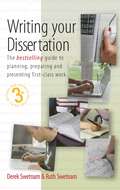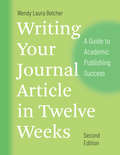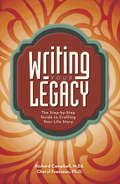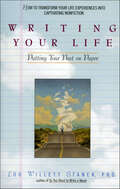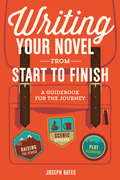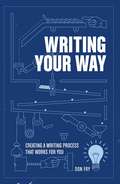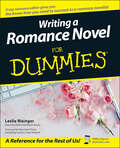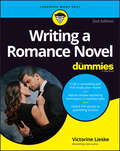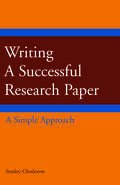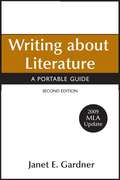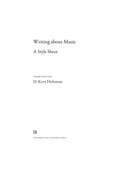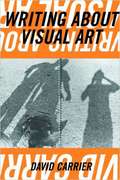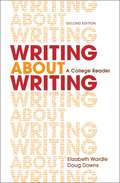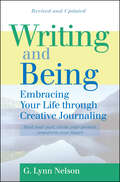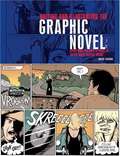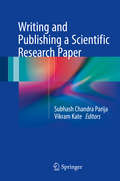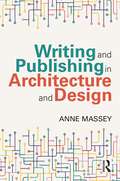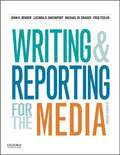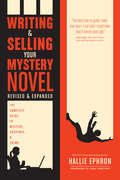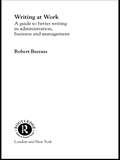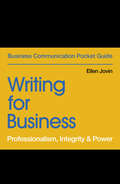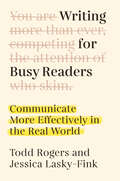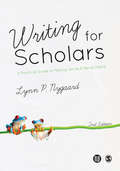- Table View
- List View
Writing Your Dissertation, 3rd Edition: The Bestselling Guide To Planning, Preparing And Presenting First-class Work (Student Handbooks)
by Derek Swetnam Ruth SwetnamGives you the tools to produce a first class dissertationThis book gives you the confidence, tools and techniques to produce a first-class dissertation. It offers practical guidelines to planning realistic timetables and structuring every aspect of your work. Find out how to avoid common mistakes and the best way to present your work, and even how to assess your dissertation in the same way as a university or college tutor does.
Writing Your Dissertation, 3rd Edition: The bestselling guide to planning, preparing and presenting first-class work
by Derek Swetnam Ruth SwetnamThis book gives you the confidence, tools and techniques to produce a first-class dissertation. It offers practical guidelines to planning realistic timetables and structuring every aspect of your work. Find out how to avoid common mistakes and the best way to present your work, and even how to assess your dissertation in the same way as a university or college tutor does.
Writing Your Journal Article in Twelve Weeks: A Guide to Academic Publishing Success (Chicago Guides to Writing, Editing and Publishing)
by Wendy Laura Belcher"Wow. No one ever told me this!" Wendy Laura Belcher has heard this countless times throughout her years of teaching and advising academics on how to write journal articles. Scholars know they must publish, but few have been told how to do so. So Belcher made it her mission to demystify the writing process. The result was Writing Your Journal Article in Twelve Weeks, which takes this overwhelming task and breaks it into small, manageable steps. For the past decade, this guide has been the go-to source for those creating articles for peer-reviewed journals. It has enabled thousands to overcome their anxieties and produce the publications that are essential to succeeding in their fields. <p><p>With this new edition, Belcher expands her advice to reach beginning scholars in even more disciplines. She builds on feedback from professors and graduate students who have successfully used the workbook to complete their articles. A new chapter addresses scholars who are writing from scratch. <p><p>This edition also includes more targeted exercises and checklists, as well as the latest research on productivity and scholarly writing. Writing Your Journal Article in Twelve Weeks is the only reference to combine expert guidance with a step-by-step workbook. Each week, readers learn a feature of strong articles and work on revising theirs accordingly. Every day is mapped out, taking the guesswork and worry out of writing. There are tasks, templates, and reminders. At the end of twelve weeks, graduate students, recent PhDs, postdoctoral fellows, adjunct instructors, junior faculty, and international faculty will feel confident they know that the rules of academic publishing and have the tools they need to succeed.
Writing Your Legacy: The Step-by-Step Guide to Crafting Your Life Story
by Richard Campbell Cheryl SvenssonCraft a meaningful life story!A written legacy of your life--one that encompasses experiences, lessons learned, failures and triumphs--is a gift your family and friends will cherish for years to come. Writing this story may seem daunting, but it doesn't have to be. Writing Your Legacy is a step-by-step guide to chronicling a life story that reflects your true self. Through a series of 35 guided themes, as well as supplementary exercises, you'll explore milestones, relationships, career paths, and major choices, and leave an eloquent record of your life for future generations.You'll also learn how to:Become the hero of your storyEmploy vibrant sensory detailsDiscover your unique voiceDig up memories from your childhood and teen yearsOvercome writer's block, address common fears, and stay motivatedPrepare your story for publicationWriting your life story can grant you insight and clarity, help you heal past wounds, and serve as a treasured account you'll be proud to share. Your story deserves to be told. Capture the spirit of your life with Writing Your Legacy.
Writing Your Life: Putting Your Past on Paper
by Lou W. StanekWe all have stories to tell -- of a rapturous first kiss, a life-altering moment of choice, or the shocking revelation of a long-guarded secret. And these stories are often as distinctive, fascinating, exciting and entertaining as those found in the memoirs and autobiographies that currently top the nation's bestseller lists. We just need to know how to tell them best.Veteran, writing teacher, lecturer, and author of So You Want to Write a Novel, Lou Willet Stanek can help you translate your joys and ordeals, thoughts and triumphs into superbly crafted nonfiction -- taking you step-by-step through the writing process with care, encouragement, and expert advice. She shows you how to unlock your memories, create settings and scenes, protray major characters and dramatic events. And she offers the key to finding your own unique voice, and to presenting your greatest charcter -- yourself -- without boring your reader or sounding egotistical.Complete with invaluable exercises, nuts-and-bolts techniques, and motivational tools, Writing Your Life is indispensible for every aspiring writer who wishes to mine the rich lode of his or her past for all the gems hidden there.
Writing Your Novel from Start to Finish: A Guidebook for the Journey
by Joseph BatesEquip yourself for the novel-writing journey!Starting a novel is exciting, but finishing it--that's the real challenge. The journey from beginning to end is rife with forks in the road and dead ends that lead many writers off course. With Writing Your Novel from Start to Finish: A Guidebook for the Journey, you'll navigate the intricacies of crafting a complex work of fiction and complete the journey with confidence and precision.To maximize your creativity and forward momentum, each chapter offers:Techniques to break down the elements of the novel--from character-building to plotting and pacingMile Markers to anticipate and overcome roadblocks like ineffective dialogue and "the unchanged protagonist"Guidelines for Going Deeper to explore and implement more nuanced aspects of storytelling, such as finding your voice and the role of themeTry-It-Out Exercises and 27 interactive worksheets that help elevate your writing.No matter your level of experience or where you are in your project, Writing Your Novel from Start to Finish provides the instruction, inspiration, and guidance you need to complete your journey successfully.
Writing Your Way
by Don FryWriters write the way they were taught, which may not suit them at all, making their writing slow, painful, and not what they want to say. Writing Your Wayshows you how to create your own unique writing process that magnifies your strengths and avoids your weaknesses. It shows you a multitude of ways to do the five key stages: Idea, Gather, Organize, Draft, and Revise. You can then design your own collection of techniques that work for you. You'll write clearer, faster, and more powerfully, with less effort and suffering. The second half of this book shows you how to create and modify your own voice, one that sounds like the real you, that sounds the way you want agents and publishers and readers to experience you.
Writing Your Way
by Don FryWriters write the way they were taught, which may not suit them at all, making their writing slow, painful, and not what they want to say. Writing Your Way shows you how to create your own unique writing process that magnifies your strengths and avoids your weaknesses. It shows you a multitude of ways to do the five key stages: Idea, Gather, Organize, Draft, and Revise. You can then design your own collection of techniques that work for you. You'll write clearer, faster, and more powerfully, with less effort and suffering. The second half of this book shows you how to create and modify your own voice, one that sounds like the real you, that sounds the way you want agents and publishers and readers to experience you.
Writing a Romance Novel For Dummies
by Leslie WaingerIn love with romance novels? You’re not alone! Romance is today’s most popular fiction genre, accounting for more than half of all mass market fiction sold. If you’re looking to make a serious effort at writing a romance and getting it published in today’s multifaceted markets, you need to learn as much as you can about this highly successful field—especially how to create the perfect heroes and heroines. Now, in this easy, step-by-step guide, a top romance editor gives you the know-how you need to succeed as a romance novelist! Writing A Romance Novel For Dummies is perfect for both beginning and more accomplished writers who are looking to get the leading edge on writing a romance novel and get it published. Leslie Wainger, Executive Editor at Harlequin Books, explains what it takes to become the next Nora Roberts, providing the techniques you need to: Select a pseudonym Write a compelling, heartfelt story Find the right agent and publisher Submit a manuscript Market your novel Join clubs and associations Packed with insider advice, this plain-English guide helps you grasp the building blocks of a great romance, providing practical tips on the craft of writing as well as savvy pointers on how to hook your reader from page one, write with passion, and shape a proposal that will wow agents and editors. You get lots of expert tips on analyzing the marketplace, creating compelling characters, and finding your own voice. Wainger also: Demystifies the sub-genres of the romance world, from historical, contemporary, and multicultural to paranormal, romantic suspense, and Christian/inspirational Explains plotting, pacing, and writing those crucial love scenes Discusses how to conduct research, assign credits, and get permissions Helps you decide whether it’s best to write alone or with a partner Complete with a manuscript preparation checklist, tips for revising your work smoothly and successfully, guidance in understanding and negotiating a contract, and a list of romance writing resources, Writing A Romance Novel For Dummies is your one-stop guide to becoming a published novelist!
Writing a Romance Novel For Dummies
by Leslie Wainger Victorine LieskeGet your romance (writing) on! Writing a Romance Novel For Dummies is the only reference aspiring writers need to get their careers off to the right start. Fully updated to reflect the industry's latest trends and secrets, this book helps you understand what makes a great novel, so you can hone your craft and write books people want to read. We break down the romance subgenres, give you expert tips on plotting and pacing, and walk you through the process of finding an agent and getting published in today’s competitive market—or self-publishing like many six-figure authors are doing. For aspiring writers longing to find success in the industry, Writing a Romance Novel For Dummies is easy to read, highly informative, and a must-have! Refine your writing to craft engaging stories readers can’t put down Find a route to publication that works for you—mainstream, or self-published Understand the ins and outs of the romance genre and its subgenres Learn how to get your work noticed in the popular world of romantic fiction This Dummies guide is perfect for beginning writers who want advice on writing and publishing a successful romance novel. It’s also a great reference for accomplished writers looking to level up their romance game.
Writing a Successful Research Paper: A Simple Approach
by Stanley ChodorowThis brief, practical guide offers a clear and comprehensive strategy for conceptualizing, approaching, and executing the task of writing a research paper in the humanities and social sciences. In addition, it provides: a critical and process-oriented approach to the tasks of topic selection, formulation of the research question, thesis development, and argumentation.judiciously selected examples drawn from a broad range of disciplines.concise treatment of the aims, methods, and conventions of scholarly research, including the opportunities and pitfalls of Internet use.a wealth of conceptual and organizational tools, and more.
Writing about Literature A Portable Guide (2nd Edition, 2009 MLA Update)
by Janet E. GardnerWriting about Literature introduces strategies for reading literature, explains the writing process and common writing assignments for literature courses, provides instruction in writing about fiction, poetry, and drama, and includes coverage of writing a research paper and of literary criticism and theory. This volume in Bedford/St. Martin's popular series of Portable Anthologies and Guides offers the series' trademark combination of high quality and great value for teachers looking to assign supplementary instruction on reading and writing about literature to their students.
Writing about Music
by D. Kern HolomanHow do you spell "Mendelssohn"? Where do you place the hyphen in "Beethoven" if it breaks between two lines? Is it "premiere" or "première"? The answers and much more can be found in this completely revised and updated resource for authors, students, editors, concert producers--anyone who deals with classical music in print. This essential volume covers some of the thorniest issues of musical discourse: how to go about describing musical works and procedures in prose, the rules for citations in notes and bibliography, and proper preparation of such materials as musical examples, tables, and illustrations. One section discusses program notes, another explains the requirements for submitting manuscripts and electronic files. A new section outlines best practices for student writers. An appendix lists common problem words.
Writing about Visual Art
by David CarrierDavid Carrier examines the history and practice of art writing and reveals its importance to the art museum, the art gallery, and aesthetic theory. Artists, art historians, and art lovers alike can gain fresh insight into how written descriptions of painting and sculpture affect the experience of art. Readers will learn how their reading can determine the way they see painting and sculpture, how interpretations of art transform meaning and significance, and how much-discussed work becomes difficult to see afresh.
Writing about Writing: A College Reader 2nd Edition
by Elizabeth Wardle Doug DownsLiteracies : where do your ideas about reading and writing come from? -- Individual in community : how do texts mediate activities? -- Rhetoric : how is meaning constructed in context? -- Processes : how are texts composed? -- Multimodal composition : what counts as writing?
Writing and Being: Embracing Your Life Through Creative Journaling
by G. Lynn NelsonWith powerful, practical, step-by-step writing exercises, a wealth of examples, and stories of personal transformation through journaling, Writing and Being demonstrates that intentional, guided journaling is a profound way to discover one's authentic self. Beyond mere diary writing, these creative journaling methods help readers chart a path for a better future. The book begins by providing tips for the logistics of journal keeping, and includes suggestions for getting started. It then explores the entire writing process and explains the distinctions between private writing and public writing. The book also explains the biology behind the powerful experience of journaling by laying out recent discoveries about the human brain, showing how journaling can heal psychological and spiritual wounds. Finally, the author shows how to make journaling both a voyage of self-discovery and a means of sharing one's journey and inspiring others in a caring community of expanding love, support, and positive energy.
Writing and Illustrating the Graphic Novel: Everything You Need to Know to Create Great Graphic Works
by Mike ChinnDramatized sequential illustrations with dialogue—an art form once confined to production of comic strips and comic books—has recently graduated into the popular, fast-growing, and often financially rewarding genre of the graphic novel. Writing and Illustrating the Graphic Novel is an authoritative instruction manual suitable for formal art class or for self teaching on the part of ambitious self-starters. Beginners who have artistic and storytelling aptitudes learn the basics of graphic novel creation, from first conception of a story idea to publication of a professionally produced book. An introductory chapter describes the widely differing graphic novel sub-genres and the appropriate styles for each. They include superhero, gothic tale, adventure/action story, sci-fi, crime story, and literary fiction. A succeeding chapter discusses and shows examples of picture panels, speech bubbles, layout, and characterization of works in progress. Subsequent chapters offer advice on finding inspiration for stories and explanation of the technique of writing for graphic novels. A variety of illustration and layout styles are shown with reference to ways in which each fits a different sub-genre. A final chapter presents practical tips on getting a graphic novel published. More than 400 illustrations take students step-by-step through the process of creating a graphic novel.
Writing and Publishing a Scientific Research Paper
by Subhash Chandra Parija Vikram KateThis book covers all essential aspects of writing scientific research articles, presenting eighteen carefully selected titles that offer essential, "must-know" content on how to write high-quality articles. The book also addresses other, rarely discussed areas of scientific writing including dealing with rejected manuscripts, the reviewer's perspective as to what they expect in a scientific article, plagiarism, copyright issues, and ethical standards in publishing scientific papers. Simplicity is the book's hallmark, and it aims to provide an accessible, comprehensive and essential resource for those seeking guidance on how to publish their research work. The importance of publishing research work cannot be overemphasized. However, a major limitation in publishing work in a scientific journal is the lack of information on or experience with scientific writing and publishing. Young faculty and trainees who are starting their research career are in need of a comprehensive guide that provides all essential components of scientific writing and aids them in getting their research work published.
Writing and Publishing in Architecture and Design
by Anne MasseyThis book outlines the process of writing and publishing research in the field of architecture and design. The book sets out to help researchers find a voice and find the best fit for their work. Information about the different types of publication on offer is set out, as well as how to make that important initial approach. From pitching an idea for a review in a magazine, to producing a journal article right through to the monograph, Writing and Publishing in Architecture and Design maps out the different steps for the novice author. Your first steps in publishing can be daunting, and the book offers material which will inspire confidence, by demystifying the publication process. It also includes valuable nuts and bolts material such as planning and structure, time management, writing styles, editing, production of the final manuscript and picture research. How do you turn your PhD into a book? How do you turn conference proceedings into a publication? Commissioning editors and authors share their experiences through interview and offer recipes for success as well as what to avoid. Key titles from the past are included as case studies, and their pathway to publication explored. This is an invaluable book for anyone working in the fields of architecture and design, with an ambition to publish.
Writing and Reporting for the Media, Eleventh Edition
by John R. Bender Lucinda D. Davenport Michael W. Drager Fred FedlerA fundamental introduction to news writing and reporting, this classic text focuses on the basics of reporting, including critical thinking, thorough reporting, excellent writing and creative visual communication skills for stories across all media, and continues to be a top resource for journalism courses.
Writing and Selling Your Mystery Novel Revised and Expanded Edition: The Complete Guide to Mystery, Suspense, and Crime
by Sara Paretsky Hallie EphronA Mystery Writers of America Edgar Award Finalist for Best Critical/Biographical Work Discover the secrets to crafting an unforgettable mystery! To piece together the puzzle of your mystery novel, you need patience, resilience, a solid understanding of the craft, and a clear blueprint for combining the plot, characters, setting, and more. And while patience and resilience must come from you, the essentials of craft and the plan to execute them are right at your fingertips with Writing and Selling Your Mystery Novel. This completely revised and updated edition features solid strategies for drafting, revising, and selling an intriguing novel that grips your readers and refuses to let them go.New York Times best-selling author Hallie Ephron shows you how to:Create a compelling sleuth and a worthy villainConstruct a plot rich in twists, red herrings, and misdirectionBring the story to a satisfying conclusionSharpen characters and optimize pace during revisionSeek publication through both traditional and indie pathsFilled with helpful worksheets and exercises for every step of the process, Writing and Selling Your Mystery Novel Revised and Expanded reveals the keys to writing a memorable story that will have fans of mystery, suspense, and crime clamoring for more.
Writing at Work: A Guide to Better Writing in Administration, Business and Management
by Robert BarrassMany employers complain about the poor communication skills of many young people seeking employment; and many people in employment are handicapped by the poor quality of their written work. While bad spelling, ineffective punctuation and faults in grammar create barriers between the writer and the reader, good English makes the reader feel at ease.The benefits of being a good writer at work are:Managers need to be able to communicate in order to get ideas across. If they cannot, they will be unable to make their viewpoint heard and they will be unable to influence customers, suppliers and colleagues as desiredIf you can write well, you will find that your views are given prominence over those of others. Effective communication, and that includes writing, is the key to career success and advancementThis book is for those who have difficulty in getting thoughts into words or their ideas across, as well as those who are satisfied with their writing but are ready to consider the possibility of improving it. It is all about the ways in which writing at work is important - helping the reader to observe, remember, think, plan, organise and communicate.
Writing for Business: Professionalism, Integrity & Power (Business Communication Pocket Guides)
by Ellen JovinBuild essential skills and write with confidence at work! Immediately practical guide to better business writing designed to help you develop a clear, direct, natural communication style that supports rather than obscures what you want to say. It covers writing principles relevant for a wide range of business documents, including email, letters, memos, reports, proposals, and more, while also offering editing tips to ensure you come across as professional and polished. Packed with examples and tips straight from the workplace.
Writing for Busy Readers: Communicate More Effectively in the Real World
by Todd Rogers Jessica Lasky-FinkWriting well is for school. Writing effectively is for life. Todd Rogers and Jessica Lasky-Fink offer the most valuable practical writing advice today. Building on their own research in behavioral science, they outline cognitive facts about how people actually read and distill them into six principles that will transform the power of your writing: Less is moreMake reading easyDesign for easy navigationUse enough formatting, but no moreTell readers why they should careMake responding easyIncluding many real-world examples, a checklist and other tools, this guide will make you a more successful and productive communicator. Rogers and Lasky-Fink bring Strunk and White&’s core ideas into the twenty-first century&’s attention marketplace. When the influential guides to writing prose were written, the internet hadn&’t been invented. Now, the average American adult is inundated with digital messages each day. With all this correspondence, capturing a busy reader&’s attention is more challenging than ever. This is how to do it.
Writing for Scholars: A Practical Guide to Making Sense & Being Heard
by Lynn NygaardLecturers request your electronic inspection copy here. Academics are not just researchers, but writers too. Using her many years of practical experience gained as a teacher and editor, Lynn Nygaard guides you through the whole process of writing and presenting your research in order to help you make your voice heard within the academic community. Grounded in real world advice rather than abstract best practice, Nygaard demonstrates a number of approaches to writing in order to help you identify those most suited to your own project. This updated new edition includes: Revised and expanded sections in each chapter More focus on the social sciences A more international focus Updated discussions on publishing practices Annotated biographies for each chapter New illustrations and images Additional practical tips and exercises From defining your audience, to forming your argument and structuring your work, this book will enable you to communicate your research passionately and professionally. Lynn Nygaard is Special Adviser on Project Development and Publications at the Peace Research Institute Oslo (PRIO). Visit the companion website for additional online resources! SAGE Study Skills are essential study guides for students of all levels. From how to write great essays and succeeding at university, to writing your undergraduate dissertation and doing postgraduate research, SAGE Study Skills help you get the best from your time at university. Visit the SAGE Study Skills hub for tips, resources and videos on study success! This updated new edition includes: Revised and expanded sections in each chapter More focus on the social sciences A more international focus Updated discussions on publishing practices Annotated bibliographies for each chapter New illustrations and images Additional practical tips and exercises From defining your audience, to forming your argument and structuring your work, this book will enable you to communicate your research passionately and professionally.
